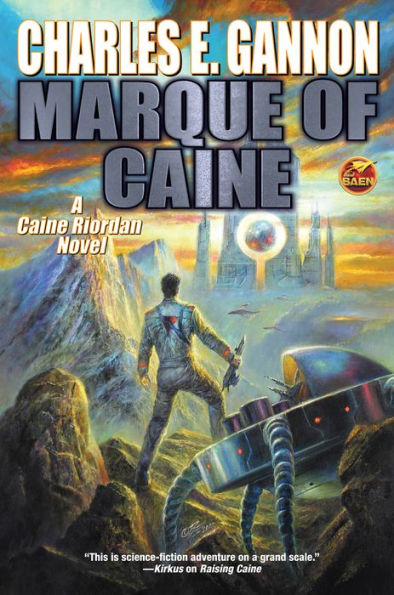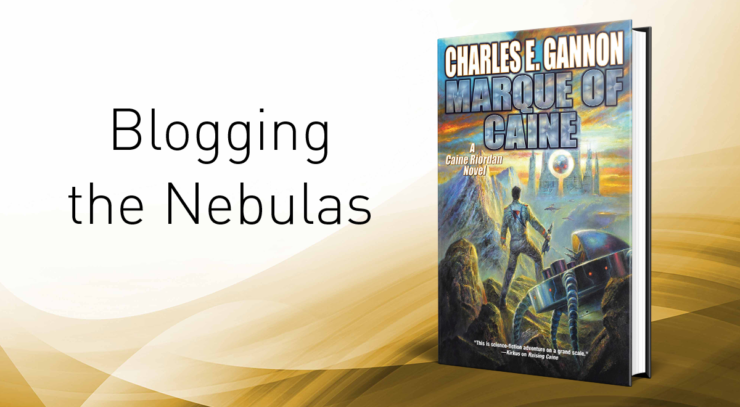The Nebula Awards could be described as the Academy Awards of SFF literature; they are voted on by the professional peers of the award nominees—members of the Science Fiction and Fantasy Writers of America. There are six nominees in the best novel category this year. Every day this week, I will be reviewing each of them and figuring their odds of taking home the prize. Welcome to Blogging the Nebulas 2020.
The Pitch
I should say up front that Marque of Caine is not a book for me. I knew this before I even cracked the cover, and my supposition was soon proven correct. For one thing, it’s a military sci-fi novel, a subgenre I generally am not drawn to despite having read and enjoyed an admittedly small number of them, including those still-read classics from Heinlein and Haldeman, more modern updates from the likes of John Scalzi (the Old Man’s War series) and Linda Nagata (the marvelous The Red trilogy), and purposefully subversive trope-skewerers like Kameron Hurley’s The Light Brigade (which missed a Nebula nod this year but is rightly ensconced on the Hugo ballot). I know there’s a lot of great milSF out there. It just doesn’t call out to me, so I don’t read much of it. (I’m a slow reader, and my time for reading books I don’t want to read—even really good ones—is limited.)
This is also the fifth book of a series, and I have read zero of its predecessors (though I was familiar with the broad outlines of the plot after editing reviews of two of the previous entries). Obviously book five is generally not where one is intended to hop onboard a series with a continuing storyline that jumps from volume to volume—though on that score, Marque of Caine is loaded with enough worldbuilding detail (so much detail!) and a plot at that stands alone fairly well (at least until it so entirely doesn’t, but I’ll get there in a moment) that I didn’t feel too lost.
All that said, the point of the Blogging the Nebulas series is to… read the books that are nominated for the Nebula for Best Novel, and so I gave this one a go, determined to get through all—gulp—700 pages of it (it’s also the longest nominee by far, and a good deal longer than a book I’d typically pick up).
Buy the Book


Marque of Caine
And how did it go? Well, about how I expected—my “this is not a book for me” suspicion was confirmed a few dozen pages in—but also, much better than I’d initially feared. Charles E. Gannon writes the sort of science fiction that used to be what people were talking about when they said “science fiction,” i.e., in a lot of ways it conforms to the expectations that someone in the 1980s who didn’t read the genre might’ve had about what sci-fi is, based largely on stereotypes about what the kinds of guys who read it (white dudes) and write it (uh, white dudes) are into. That’s not to say these assessments are strictly fair, now or then; the genre has always been a lot more diverse than outsiders give it credit for, and for a long time, all those white dude books were really popular (the reasons for which are vast and hotly debated, and definitely not my point, here).
In short: yeah, though he comes at things with a somewhat more modern sensibility and a healthy appreciation for shades of grey, Charles E. Gannon writes the kind of SF that was popular with a large swath of the genre establishment a few decades ago and seems to be somewhat less popular now, depending on which publishing conspiracy theories you subscribe to. But he writes it reasonably well—well enough to engage the attention of even a resistant reader like me, which has got to be worth something.
The plot is surprisingly easy to elide in a summary given the book’s length. The series’ protagonist is Caine Riordan, sort of a cross between your stock super-competent Heinlein hero and Jack Ryan. In his past life on Earth a century hence, he was an intelligence analyst who uncovered something he shouldn’t have and was put on ice for a decade or so, only to wake up and find the world changed after making first contact with aliens. Despite being a desk jockey, he’s gifted with the skills in battle to match his keen intellect, and (I gather) has spent four books becoming embroiled in plots and counterplots involving government malfeasance and corporate intrigue related to humanity’s entry into a larger galactic body governed by a treaty known as the Accord.
Marque of Caine opens two years after the end of the previous novel, Raising Caine, during which our hero was relieved of his command for “following his conscience,” or so the back cover tells me, and he has spent most of that time waiting to hear word of his MIA paramour, Elena, who was mortally wounded in an earlier book and has since been in the custody of a powerful, ancient alien race known as the Dornaai, ostensibly to be healed by their advanced tech. Caine receives a summons to the Dornaai homeworld and expects to be reunited with his love, but instead is drawn into further galactic intrigue of great import to both the characters and people planning to read more of these books, but not so much to me.
Most of the novel is not concerned with the plot so much as exploring the background of the Dornaai themselves, and they are an intriguing creation: A civilization so old and so advanced, they’ve forgotten much of their own history and have begun a slow decline invisible to most of the rest of the galaxy (but not to Caine Riordan). Gannon has obviously thought very deeply about the hows and whys of the Dornaai: in terms of building out his world, yes, but also in how he has extrapolated from their plight to illustrate the novel’s (and series’, from what I can gather) general theme: that even as a system or government strives for the ideal, concessions to those ideals will have to be made in pursuit of the greater good, and it’s up to the people living within them to make sure that those moral sacrifices are worth carrying out to protect said system, and vice versa.
The deep dive into the Dornaai is interesting enough, and I found I enjoyed the main character in spite of his lack of flaws. There was admittedly quite a bit I had to sort of skim past in my quest to reach the final page—many long discussions about military and political strategy, a good deal of clunky dialogue, a lot of digression—but I do think that has more to do with my personal taste than the book itself; certainly the Goodreads reviews suggest that most readers feel this is one of the strongest entries in the series. I can’t say I was thrilled to discover that a lot of the plot turns out to be setup and the book ends without much in the way of resolution. Cliffhangers are, of course, a part of serial storytelling. But they are only satisfying if you know you’ll be going on to the next book to see what happens. I won’t be, but your mileage, as they say, may vary.
Why it could win
Marque of Caine is the fourth book in the Caine series to be Nebula nominated; only 2017’s Caine’s Mutiny has missed the, er, mark so far. Clearly Gannon has a lot of fans in SFWA, and eventually he might amass enough of them to push him over the edge.
Though series-starters logically tend to fare better when it comes to awards in general and the Nebulas in particular (N.K. Jemisin’s recent third-of-three victory notwithstanding) it is unusual but not unprecedented for an oft-nominated author to get several books deep into a space opera series before winning: most recently, Jack McDevitt took home top honors in 2007 for Seeker, book three of the Alex Benedict series, after six earlier nominations.
And for what it’s worth, with four nods, the Caine Riordan series is now one of the most Nebula-nominated series in history, standing with the likes of Gene Wolfe’s Book of the New Sun (four nominations), McDevitt’s Alex Benedict novels (five nominations), and Lois McMaster Bujold’s Vorkosigan Saga (five nominations). That’s no small feat. I suspect it garnered so many because Gannon is very good at what he does: For readers who are seeking this sort of thing—a deep dive into an alien culture, hard SF rigor tempered with action and engaging characters, a plot and structure that rewards attention to detail, deeply considered themes of military service and sacrifice—this book (and series) certainly delivers.
Why it may not win
Marque of Caine is the fourth book in the Caine series to be Nebula nominated, and none of them have won. It only stands to reason that as the barrier to entry for new readers increases, the number of votes it’s going to pick up is likely to drop, barring the sort of cultural zeitgeist moment that likely helped push Jemisin over the edge with book three of The Broken Earth. Getting a nomination is one thing, but winning is another; to take the prize, Gannon’s novel is going to have to impress a significant number of voters in a very competitive field.
And speaking of the zeitgeist, there’s no getting around the fact that Marque of Caine represents a very different vision of SFF than its fellow nominees this year. In each their own way, the other five books vying for the Nebula seek to defy classic genre conventions, interrogate tired tropes, and celebrate inclusivity. That isn’t to say that they were nominated just for doing so—none of that in the comments, please—but it’s a fact that undeniably sets them apart from Gannon’s novel, which fits better into an older mode of SFnal storytelling and, as a result, likely appeals to a very different reader. And judging by the winners over the last half-decade or more, there may not be enough of those readers—or voters—to put Marque over the top.
All that said, if an old-school sci-fi actioner exploring an alien culture at the micro level sounds like your thing, by all means, give this series a go—you don’t get four nominations for one of genre’s top awards if you’re not doing something right.
Joel Cunningham was the founding editor of the B&N Sci-Fi & Fantasy Blog (RIP), where he explored the galaxy for 5 years, picking up a Hugo Award (well, tangentially) along the way. He’s now managing editor of Lifehacker, which means he’s managing at least one thing nowadays. He lives in an apartment in Brooklyn with his wife and two children and hopes to go outside again someday. He tweets @joelevard.










